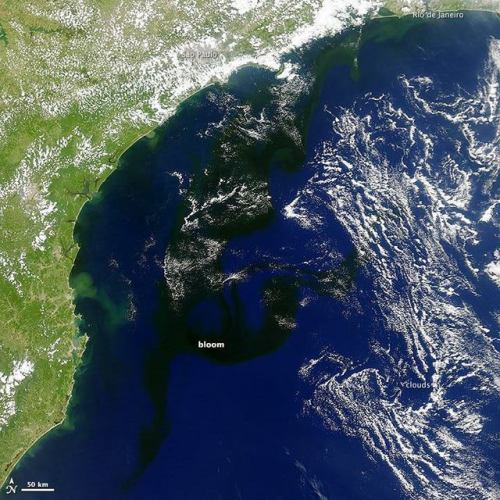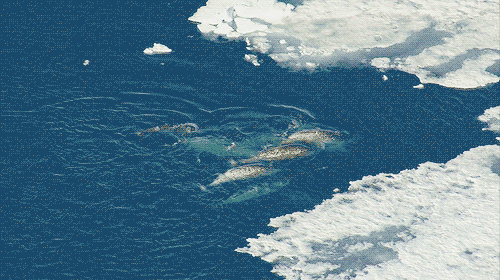More On Phytoplankton To Come Soon! Check Out My First Introductory Post If You Missed It.
More on phytoplankton to come soon! Check out my first introductory post if you missed it.

Phytoplankton: An overview of the small, plant-like organisms that make the world go round.
http://becausephytoplankton.blogspot.com/2017/11/what-are-phytoplankton.html?spref=tw
Image Credit: NASA/Goddard/Aqua/MODIS via Flickr
More Posts from Simplyphytoplankton and Others

Covering the oceans in darkness….
Phytoplankton blooms produce some fascinating textures in Earth’s oceans, and consequently we’ve shared images of them taken from orbit many times (http://tinyurl.com/qhzwbr9, http://tinyurl.com/pwasxol). This bloom, however is a bit different from the others – in this photo from NASA’s Aqua satellite, it looks, well, black.
Keep reading
Why Octopuses Could Never Disappoint
These cephalopods, who telegraph their moods by color changes and solve problems by using tools, have surprised me again and again.
And now it’s happened again. An octopus has astonished me.
This time, it’s a common octopus caught on camera in South African waters by a dive team for the documentary Blue Planet II, currently airing on BBC America in the United States.
The action is dramatic. A pyjama shark seizes the octopus. Just as the situation begins to look dire, the octopus stuffs the shark’s gills shut using its sinuous arms, making it impossible for the shark to breathe — until the shark releases it.
Announcement!
With only a few days until Valentines day it is my scientific duty to inform you all that if you don't have a valentine yet, an algal cell will be your valentine. They will be assigned automatically and love you with all their chloroplasts. You may not opt out, but a platonic algae-mate will be assigned to those who are not romantically inclined.

Meet your new alBAE 💚💚.



Showing off those glide and pivot skills 😶🌫️
Fishes in the family Macrouridae, also known as rattails, can glimpse even the faintest flickers of bioluminescence—the “living light” produced by deep-sea animals. Their keen eyesight reveals prey, like fishes and squid, darting in the waters above the seafloor. A rattail relies on other senses, like smell and touch, to find a meal too. It has a nose for rotting carrion, and sensitive barbels on its chin detect small crustaceans or worms wiggling in the mud below.



Evo-Devo (Despacito Biology Parody) - A Capella Science
This is how we go from single cells to people.
Fellow Study Abroad Students
Most Common Profile
Fellow Students
My Background
Adjustments
The most common profile in study abroad is students from "elite colleges, white, female, major in arts/humanities, and have highly educated parents." Let's see how that compares to me. I am from a small liberal arts school (does that count as elite?), I am white (check), male (nope), I have majors in biology (nope) and Spanish (check), and both of my parents completed high school but never went to college so they would not be considered highly educated.
Now, compared to my fellow study abroad students, that profile fits a bit more. Girls out number guys by slightly more than 2 to 1, most of us are white, I think there are two science majors max (including myself), we have representatives from American University and other liberal arts schools, and I know at least some of them have parents that are medical doctors or have a doctorate in the arts or humanities. This is my first time outside the United States, but I know that at least five others have spent at least a few weeks outside of the U.S. at some point in their lives. So overall, everyone else is more well-traveled than me.
In general, I usually do not think that my background as a first generation college student affects my interactions with my peers. I think it's a little awkward when someone says that their father is a doctor or that their father has a Ph.D. in Philosophy, but usually, it's just someone that comes up in a casual conversation and they do not expect me to say what my parents do.
I think that I have learned to be independent and I usually do not rely on others when navigating the college system, and I think that is probably also true for learning how to adjust to life abroad. I just need some time and I make the adjustments on my own. I'm sure that the students that have been abroad may be able to adjust easier, but I don't really know if it is that different from my fellow study abroad students.
By a 3-0 vote, the 9th U.S. Circuit Court of Appeals said the government fell short of the “high bar” needed to dismiss the Oregon case, originally brought in 2015 against the administration of President Barack Obama.
Twenty-one children and young adults, ages 11 to 22, accused federal officials and oil industry executives of violating their due process rights by knowing for decades that carbon pollution poisons the environment, but doing nothing about it.
The government contended that letting the case proceed would be too burdensome, unconstitutionally pit the courts against the executive branch, and require improper “agency decision-making” by forcing officials to answer questions about climate change.
But the appeals court said the issues raised “are better addressed through the ordinary course of litigation.”
A trial is scheduled for Oct. 29 in the federal court in Eugene, Oregon.
President Donald Trump’s administration also has asked the U.S. Supreme Court to dismiss the lawsuit or put it on hold, and is awaiting a ruling. Its earlier bid to end the lawsuit failed in March.
-
 simplyphytoplankton reblogged this · 6 years ago
simplyphytoplankton reblogged this · 6 years ago -
 hamisciprus reblogged this · 7 years ago
hamisciprus reblogged this · 7 years ago -
 hamisciprus liked this · 7 years ago
hamisciprus liked this · 7 years ago -
 mooonborne reblogged this · 7 years ago
mooonborne reblogged this · 7 years ago -
 wrasse72 reblogged this · 7 years ago
wrasse72 reblogged this · 7 years ago -
 wrasse72 liked this · 7 years ago
wrasse72 liked this · 7 years ago -
 simplyphytoplankton reblogged this · 7 years ago
simplyphytoplankton reblogged this · 7 years ago

Blog dedicted to phytoplankton. Phytoplankton are microscopic organisms that are responsible for half of the photosynthesis that occurs on Earth. Oh, and they look like art... Follow to learn more about these amazing litter critters! Caution: Will share other ocean science posts!Run by an oceanographer and phytoplankton expert. Currently a postdoctoral researcher.Profile image: False Colored SEM image of Emiliania huxleyi, a coccolithophore, and the subject of my doctoral work. Credit: Steve Gschmeissner/ Science Photo Library/ Getty ImagesHeader image: Satellite image of a phytoplankton bloom off the Alaskan Coast, in the Chukchi SeaCredit: NASA image by Norman Kuring/NASA's Ocean Color Web https://earthobservatory.nasa.gov/images/92412/churning-in-the-chukchi-sea
158 posts
